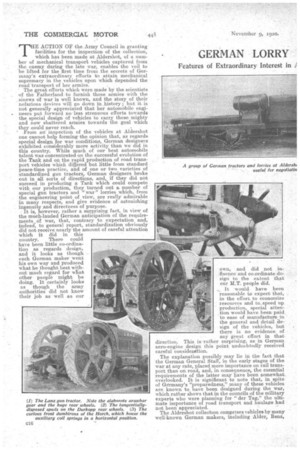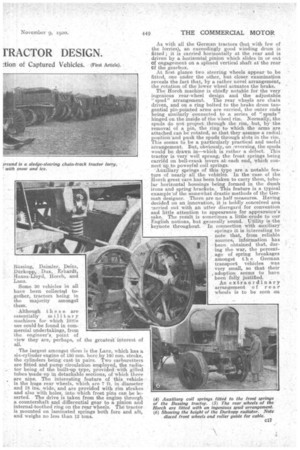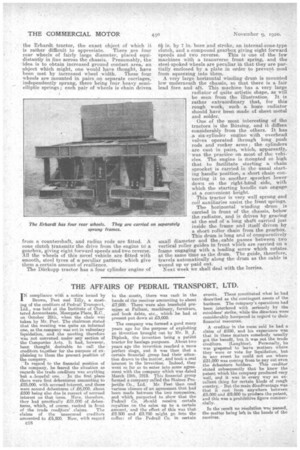GERMAN LORRY FRACTOR DESIGN.
Page 40

Page 41

Page 42

If you've noticed an error in this article please click here to report it so we can fix it.
Features of Extraordinary Interest in I tion of Captured Vehicles. (First Article). THE ACTION OF the Army Council in granting facilities for the inspection, of the collection, which has been made at Aldershot, of a number of mechanical transport vehicles captured from the enemy during the late war, enables the veil to be lifted for the first time from the secrets of Germany's extraordinary efforts to attain mechanical supremacy in the vehicles upon which depended the road transport of her armies.
The great efforts which were made by the scientists of the Fatherland to furnish those armies with the sinews Of war is well known, and the story of their nefarious devices will go down in history ; but it is not generally appreciated that her automobile engineers put forward no less strenuous efforts towards the special design of vehicles to carry those mighty and now shattered armies towards the goal which they could never reach. .
* From an inspection of the vehicles at Aldershot one cannot help forming the opinion that, as regards special design for war conditions, German designers exhibited considerably more activity than we did in this country. While much of our best automobile talent was concentrated on the successful evolution of the Tank and on the rapid production of road transport vehicles which digered but little from standard peace-time practice, and of one or two varieties of standardized gun tractors., German designers broke out in all sorts of directions, and, if they did net succeed in producing a Tank which could compete with our production, they turned out a number of special gun tractors and r war " lorries which, from the engineering point of view, are really admirable in many respects, and give evidence of astonishing ingenuity and directness of purpose.
It is, however, rather a surprising fact, in view of the much-lauded German anticipation of the requirements of war, that, contrary to expectation and, indeed, to general report, standardization obviously did not receive. nearly the amount of careful attention which it did in this country. There could have been little co-ordination as regards design, and it looks as though each German maker went his own way and produced what he thought best without much regard for what other people might be doing. It certainly looks as though the army authorities did not know their job as well as our
own, and did not influence and co-ordinate design to the extent that our M.T. people did.
It would have been reasonable to expect that, in the effort to economize resources and to...speed up production, special atten.tion would have been paid to ease of manufacture in the general and detail design of the vehicles, but there is no evidence of any great effort. in that direction. This is rather surprising, as in German aero-engine design this point undoubtedly received careful considengtion.
The explanation possibly may lie in the fact that the German General Staff, in the early stages of the war at any rate, placed more importance on rail transport than on road, and, in consequence the essential requirements of the latter may have been somewhat, overlooked. It is significant tonote that, in spite of Geormany's "preparedness," many of these vehicles are known to have been designed during the war, which rather shows that in the councils of the military experts who were planning for "der Tag," the ultimate importance of road transport and haulage had not been appreciated.
The Aldershot collection comprises vehicles by many well-known German makers, including Alder, Benz, Bussing, Daimler, Deitz, Diirkopp, Dux,. Erhardt, Hansa-Lloyd, Horeh, and Lanz.
Some 30 vehicles in all have been collected together, tractors being in the majority amongst them.
Although these are esSentially in ilitary machine-8 for which little use could be found in commercial undertakings, from the engineer's, point of view they are,. perhaps, of the greatest interest of
The largest amongst them is the Lanz, which has a six-cylinder engine of 150 mm. hereby 160 mm. stroke, the cylinders being cast in pairs. Two carburetters are fitted and pump circulation employed, the radiator being of the built-up type, provided with gilled tubes Made. up in detachable sections, of which there are nine. The interesting feature of this vehicle is the huge rear wheels, which are 7 ft. in diameter and 18 ins, wide, and are provided with rim strakes and also with holes: into-which frost pins can be ieserted. The drive is taken from the engine throirgli a countershaft and differential gear to a pinion and internal-toothed ring on the rear wheels. The tractor is mounted on laminated springs both fore and aft,
and weighs no less than 12 tons. • As with all the German tractors (but with few of the lorries), an exceedingly good winding drum is
fitted-; it is carried horizontally, at the rear and is driven by a horizontal pinion which slides in or out Of engagement on a splined vertical shaft at the rear Of the gearbox.
At first glance two steering wheels appear to be fitted, one under the other, but closer examination reveals the fact that, by a rather. novel arrangement, the rotation of the lower wheel actuates the brake.
The Horch machine is chiefly notable for the very ingenious rear-wheel design and the adjustable "spud" arrangement. The rear wheels are chain driven, and on a ring bolted to the brake drum tangential pin-pointed arms are carried, the outer ends
being similarly -connected to a series of "spuds" hinged on the inside of the wheel rim_ Normally, the spuds do not project through the run, but, by the removal of a pin, the ring to which the arms are attached can be rotated, so that they assume a radial, position and push the spuds through slots in the rim. .
This seems to be a particularly practical and useful arrangement. But, obviously, on :.eversing, the spuds would be drawn in—which is rather a defect. This tractor is very well sprung, the front springs being carried on bell-crank levers at each end, which connect up to powerful coil springs. Auxiliary springs of this type are a notable feature of nearly all the vehicles. In the case of the Horeb great care has been taken to carry them, tubu lar horizontal housings being formed in the dumb irons and spring brackets. This feature is a typical example of the somewhat drastic methods of the Ger man. designer. There are no half measures. Having decided on an innovation, it is boldly conceived an earried out with an litter disregard for convention and little attention to appearance for appearance's sake. The result is sometimes a little crude to our
English notions, but generally sound. Utility is the keynote throughout. In connection with auxiliary. springs it is interesting to note that, from reliable sources, information has . been obtained that, during the war, the percentage of spring breakages amongst t h e German transport vehicles was very small, so that their adoption seems to have been fully justified.
An extraordinary arrangement of rear wheels is to be seen. on the Erhardt tractor, the exact object of which it is rather difficult to appreciate. There are four rear wheels of fairly large diameter, placed equidistantly in line across the chassis. Presumably, the idea is to obtain increased ground contact area, an object which might, one would have thought, have been met by increased wheel .width. These four wheels are mounted in pairs on separate carriages, independently sprung, there being folir heavy semielliptic springs; each pair of wheels is chain driven
from a countershaft, and radius rods are fitted, A cone clutch transmits the drive from the engine to a gearbox, giving eight forward speeds and two reverse. All the wheels of this novel vehicle are fitted with smooth, steel tyres of a, peculiar pattern, which give them a certain amount of resilience.
The Diirkopp tractor has a four cylinder engine of
oi in. by 7 in. bore and stroke, an internal-cone-type clutch, and a compound gearbox giving eight forward
speeds and two reverse. This is one of. the few machines with a transverse front spring, and the steel-spoked wheels are peculiar in that they are partially enclosed by a plate in order to prevent mud from squeezing into them. A very large horizontal winding druni is mounted law underneath the chassis, so that there is a. fair lead fore andaft. This machine has a very large radiator of quite artistic shape, as will be seen from the illustration. It is rather extraordinary that, for this rough work, such a huge radiator should have been made of sheet metal and solder.
One of the most interesting of the tractors is the Bussing, and it differs
considerably from the others. It has .a six-cylinder engine with overhead valves operated through long push rods and rocker arms ; the cylinders are cast in pairs, which, apparently, was the practice on most of the vehi cles. The engine is Mounted so high that to facilitate starting a chain sprocket is carried. in the usual start
ing handle position, a short chain connecting it to another sprocket lower down on the right-hAnd side, with which the starting handle can engage at a convenient height.
This tractor is very well sprung and coil auxiliaries assist the Front springs.
The horizontal winding drum is carried in front of the chassis, below the radiator, and is driven by gearing at the end of a long shaft carried just inside the frame and itself driven by a short rollerchain from the gearbox.
This drum is long and of comparatively small diameter and the ,calale passes between two vertical roller guides in front which are carried on a frame engaging with a leading screw which rotates at the same time as the drum. The guide, therefore, travels automatically along the drum as the cable is wound up or paid out. Next week we shall deal with the lorries.


























































